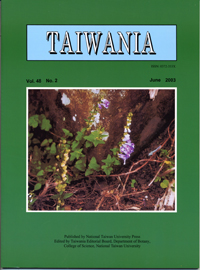Research Paper
Wall Structure During Stages in Development of Selaginella pulcherrima and S. haematodes Megaspores
Marta A. Morbelli, John R. Rowley and Gamal El-Ghazaly
Published on: June 2003
Page: 77 - 86
DOI: 10.6165/tai.2003.48(2).77
Abstract
There are hundreds of exospore units that extend across the gap and into the mesospore in middle stages in megaspores of Selaginella pulcherrima Liebm.ex Fourn and S. haematodes (Kunze) Spring. The mesospore of these megaspores is resistant to acetolysis during middle stages suggesting the presence of sporopollenin. There are also spheroidal structures that are resistant to acetolysis on the surfaces of the outer and inner exospore in both species in middle and mature stages. In late stages the mesospore no longer exists and the inner exospore is a narrow stripe, i.e., there is no longer a space (gap) between outer and inner parts of the exospore. Our interpretation for the loss of the mesospore is that sporopollenin does not become polymerized under physiological conditions to its exceptional state of resistance to reduction, but does so when exposed to native or experimental oxidation; in our case, exposure to the atmosphere by cutting open the megaspore and plunging it into the acetolysis mixture.
中文摘要
美麗卷柏及紅色卷柏之大孢子在發育中期,會有數以百計的外壁單元穿過間隙(gap) 進入中壁層。這些發育中期的中壁層可抵抗酸化分解,顯示其中已有孢粉素存在。此兩種卷柏之大孢子發育中期及成熟時期,大孢子的外壁之內、外表面上皆具有球狀構造,此構造亦能抵抗酸化分解。發育晚期,中壁層消失,外壁內層僅呈一條細帶,亦即外壁層的內、外層之間的空隙已不再存在。我們推論:中壁層的消失並非其在抗還原期(特殊的發育期)之生理作用使然,而是大孢子由於本身特性而暴露於大氣中,或在實驗操作中氧化,而使得孢粉素聚合化並使中壁層消失。在我們的例子中,由於切開大孢子使其暴露於大氣中,又加以酸化處理才獲至此結果。
Keyword: Exospore unit structures, Megaspores, Mesospore resistance, Mesospore degrading, Selaginella


